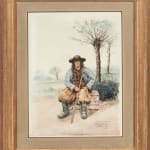Jules Bastien-Lepage (1848-1884)
Jules Bastien-Lepage was born in the village of Damvillers on 1 November 1848. His father grew grapes to support the family. He took an early liking to drawing, and his parents fostered his creativity by buying prints of paintings for him to copy. Bastien-Lepage’s first formal training was at Verdun. In 1867, he was admitted to the École des Beaux-Arts in Paris, studying with Alexander Cabanel. He was awarded first place for drawing but spent most of his time working alone, only occasionally appearing in class. Nevertheless, he completed three years at the academy.
Bastien-Lepage was wounded in the Franco-Prussian War of 1870-1871, returning home to immortalize family and villagers of north-eastern France. His Portrait of my Grandfather from 1873, exhibited at the Salon the same year, earned him his first public success. That same year, he was commissioned to portray the Prince of Wales. In 1875, he placed second at the Prix de Rome. His next endeavor to win the Grand Prix de Rome the following year with Priam at the Feet of Achilles, now in the Palais des Beaux Arts in Lille, was again unsuccessful, and the painter returned to country life. To the Salon of 1877, he sent a full-length Portrait of Lady L. and My Parents; and in 1878 a Portrait of M. Theuriet and The Hayfield, now in the Musée du Luxembourg.
From then on, Bastien-Lepage was widely recognized in France as a naturalistic painter. His Portrait of Sarah Bernhardt from 1879 won him the Legion of Honour. In 1880 he exhibited a Portrait of M. Andrieux and Joan Of Arc listening to the Voices, now in the Metropolitan Museum of Art. The same year, at London’s Royal Academy, the little portrait of the Prince of Wales was shown. Once well established, Bastien-Lepage traveled to England, Switzerland, and Italy. The artist, struggling with his health, returned to Paris in 1884 where he died of cancer at the young age of thirty-six. A posthumous exhibition of more than 200 of his pictures was presented at the École des Beaux-Arts.
The present drawing was executed in Saint-Brieuc, a village in the Côtes-d’Armor region of Brittany. Dedicated to Bastien-Lepage’s friend Olivier Métra (1830-1889), a composer and conductor, it predates a watercolor of the same subject, now in the Baltimore Museum of Art. Curiously, this second drawing is dated 1880 and inscribed Dinar, a coastal village in Brittany about 80 kilometers from Saint-Brieuc, lacking the detailed background of our.[1] A drawing of a female Breton peasant, dated 1876, also inscribed Saint-Brieuc, could possibly be a pendant to our drawing.[2]
[1] Marie-Madeleleine Aubrun, Jules Bastien-Lepage 1848-1884, Paris 1985, cat.no. 540, p. 307, only published the Baltimore watercolor in her catalogue raisonné, with the notion that the location “DINAR (sic)” must be erronous. A second variant in watercolor, Breton assis Dinar, also dated 1880 and measuring 320 x 241 mm, appeared on the art market recently.
[2] Sale, Galerie Bassenge, Berlin, 26 November 2010, lot 6349
Provenance
Private collection, United KingdomSotheby's, London, 15 November 1995, lot 81
The Garden & selected watercolours & oil paintings, Sotheby's Summers Place, Billingshurst, West Sussex, 22 May 1997, lot 220
Private collection, The Netherlands



